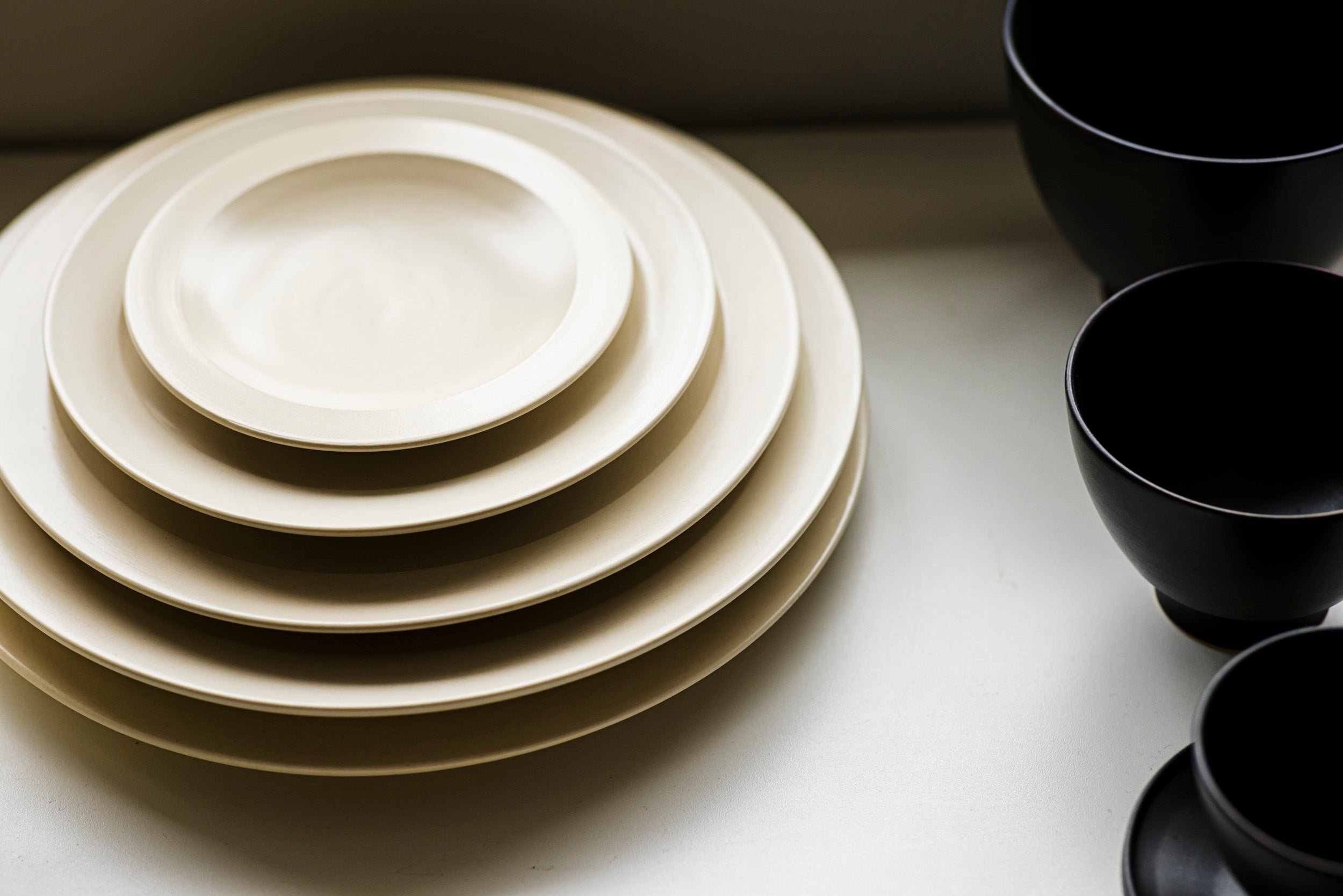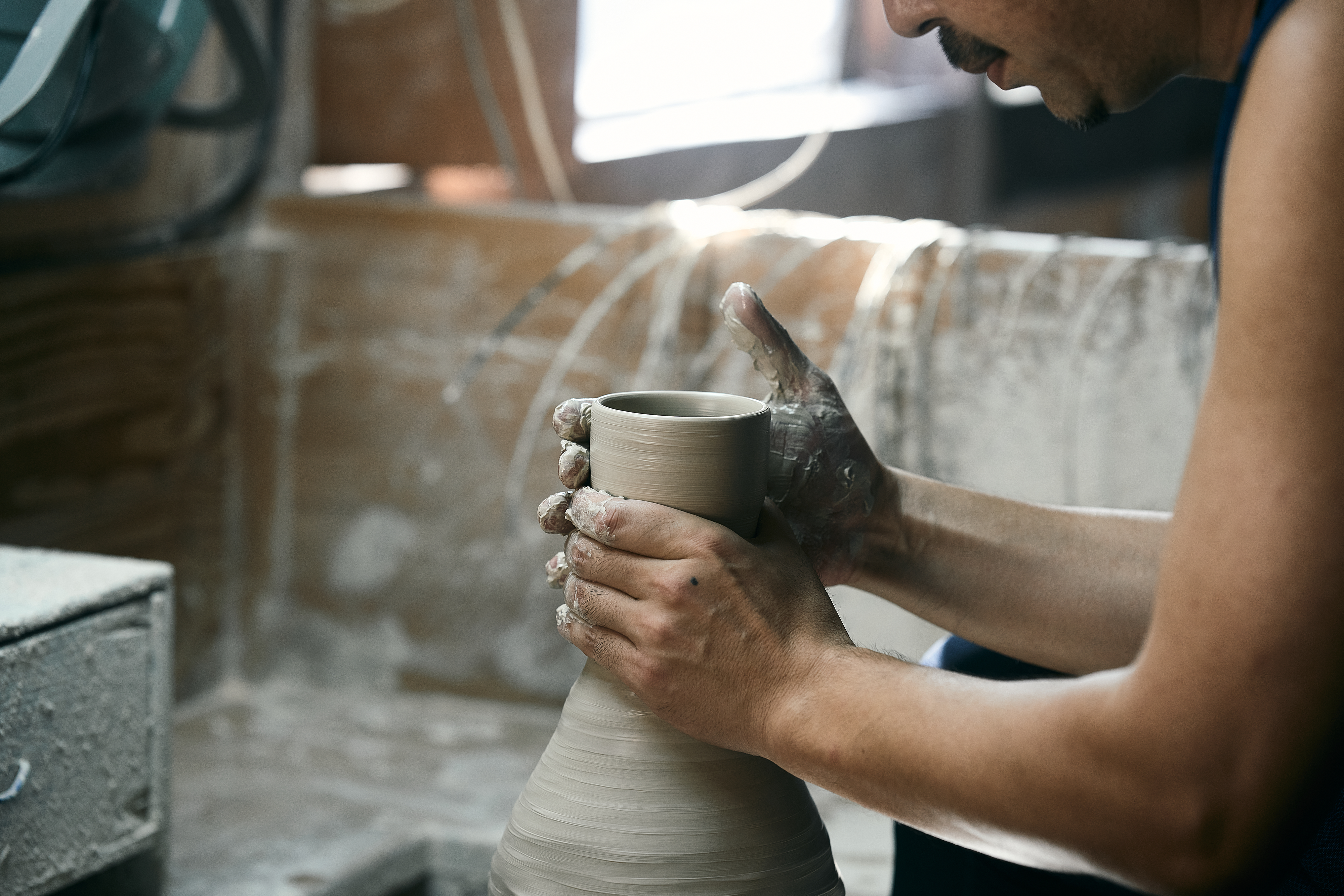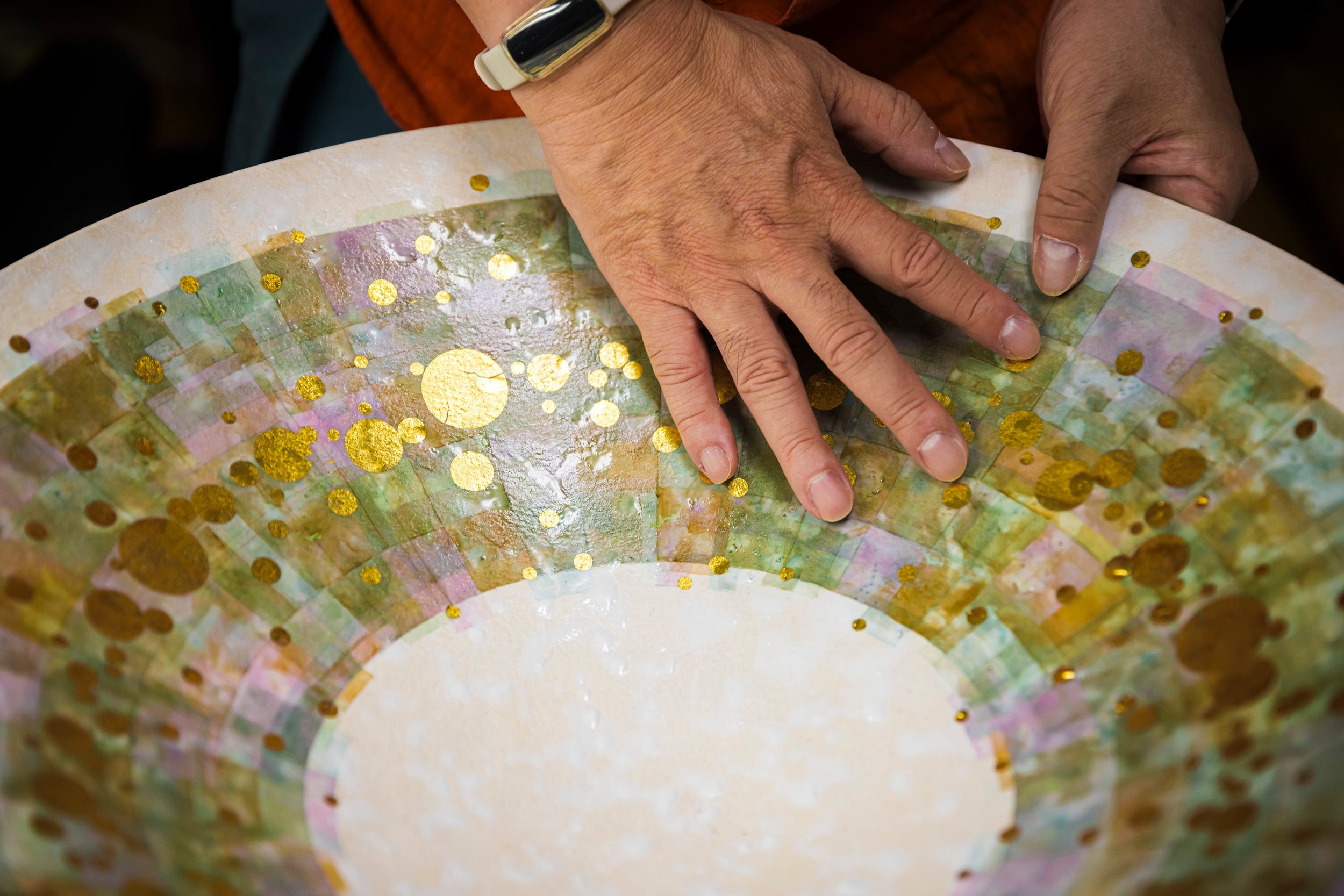
「HANASAKA」の白に何をみるか【第二話】
九谷焼の新しい可能性を求めて
絵付けのない九谷焼。その開発には「谷口製土所」の産地や伝統に対する熱い想いが込められていました。天然資源の花坂陶石を有効に活用し、九谷焼の新しい可能性を模索するHANASAKAシリーズの「Une(ユンヌ)」。“白久谷”とでも呼びたくなる素肌のような美しさからは、九谷焼のもう一つの魅力が見えてくるようです。

新しい久谷の可能性
花坂陶石そのものは黄味がかった乳白色をしています。昔の九谷焼は素材の風合いを活かす「酸化焼成」が主流でしたが、現在では上絵付の鮮やかさを際立たせるために素地(きじ)を白く仕上げる「還元焼成」という焼き方が主流です。この「白素地」と呼ばれる状態まで制作する窯の一つ、旭山窯では酸化焼成で焼き上げる希少な窯元。「Une(ユンヌ)」は四代目の東 一寿さんの手によって作られています。
「東さんも自分の窯で完成品まで作るのはあまり経験がなかったので、デザイナーの戸田 祐希利さんを交えて3人で何度も調整しました。形をデザインしても轆轤で回すと重さや構造的に形状が保てないこともあり、その場合は外側のフォルムを活かして東さんに作り方を考えてもらったりしました。さらに、釉薬も温度によって表情が変わるので、マットの具合など窯元で質感のチェックには余念がありませんでした。粘土の納品でしか訪れてこなかった旭山窯でしたが、色々と相談するようになってから東さんの本気の職人魂に触れた気がします(笑)」

轆轤の技術は久谷焼きの屋台骨を支えている。

粘土だけでなく、今後は釉薬も販売していく。

地層のように重なった花坂陶石に歴史の重さを感じる。

機械化は進んでいるものの、基本的には昔からの製法を守っている。

豊富なバリエーションで、食洗機も使える。
無垢な風土を表現した「花坂の白椀」
2021年には、デザイナーの原 研哉と「花坂の白椀」を制作。実物を拝見すると、いわゆる花坂陶石の色がそのまま出ていて、白というよりは淡いグレーにアイボリーが混ざったような表情です。
「これは2021年に行われた北陸工芸の祭典『GO FOR KOGEI』でのことで、日本を代表するデザイナーの原さんとタッグを組ませていただきました。原さんといえばやはりピュアホワイトが象徴的なのですが、私の思いとして混ぜ物をして作られた純白ではなく、何も手を加えない無垢な状態を“白”とすることで素材や産地の特徴を表現できないか提案したのです。純度100%の花坂陶石では焼きによる“黒点”も現れるし、成形も難しい。色も曖昧な表情になるかもしれないけれど、それが本当の姿なのです。原さんはその想いを受け止めてくれて、お椀を積み重ねたときに揺らぎを与えるデザインを考え、久谷焼きでありながら日々使いやすく、それでいて潤いを与えるような作品を提案してくれました」

伝統工芸と自分の未来のために、できることから始めていく。

原さんとのプロジェクトは「Une(ユンヌ)」にも良い影響を与えた。

今後もさまざまなバリエーションを展開していく。
久谷の土を作り続けていく
地球の息吹ともいえる火山活動から誕生した花坂陶石。谷口製土所の工場を見ていると、まるで地層のように至る所に土や泥が積層されています。実は九谷焼といっても、その成型方法は多岐にわたります。例えば型を使う「鋳込み」の窯には粘りを控えめにして型離れの良い粘土を届けるなど、用途に合わせた粘土の調合が谷口さんの腕の見せ所です。看板商品の磁器土も、伝統的な久谷焼きに適した轆轤用に調合したものだけでなく、産業用といわれる久谷焼きの作家に合わせたもの、白さと透明度を高めたランプシェード用の土など、さまざまな種類の粘土を製造していて、その種類は多彩です。しかし「材料だけでやっていくのは難しくなる」と話す谷口さんに、それでも続けていく理由を尋ねると「自分が後を継いだときに喜んでくれた人がたくさんいたから」と、照れたように笑います。
「旅口製土所が土作りを止めたら 仕事が亡くなる人がたくさんいるのです。父親も近所の窯元も誰も継げとは言わなかったけど、内心ヒヤヒヤしていたでしょうね(笑)。だから、自分は土を作り続けていかなきゃいけないのです。HANASAKAシリーズも自社ブランドを作ることで少しでも生産量を上げたいし、残土を少しでも活用していかなければ今ある鉱脈だっていつかは尽きてしまう。そうなる前に、みんなでやれることをどんどん増やしていかなきゃいけないですよね。若い人にも関心を持ってもらいたいし、しっかり稼げる仕事にしていかなければ、無くなってからでは取り返しが付かない。絵付けの窯元も白素地を作る窯元も土屋もみんなが一緒になって新しいことに挑戦する。それが久谷焼きの精神だと思っています」
谷口さんの話を聞きながら、HANASAKAの淡く優しい白さはたくさんの可能性が詰まった余白なのだと感じます。使い込むほどに、わずかな釉薬の艶や色味が変化していくことに気付きます。それは、上絵がない九谷焼の素直な変化。そうしたささやかな変化に気付くとき、いっそう愛着が湧いてきそうです。

無垢の白から見えてくる未来がある。

「人の心に花を咲かせるHANASAKAを目指す」と、谷口さんは笑う。



